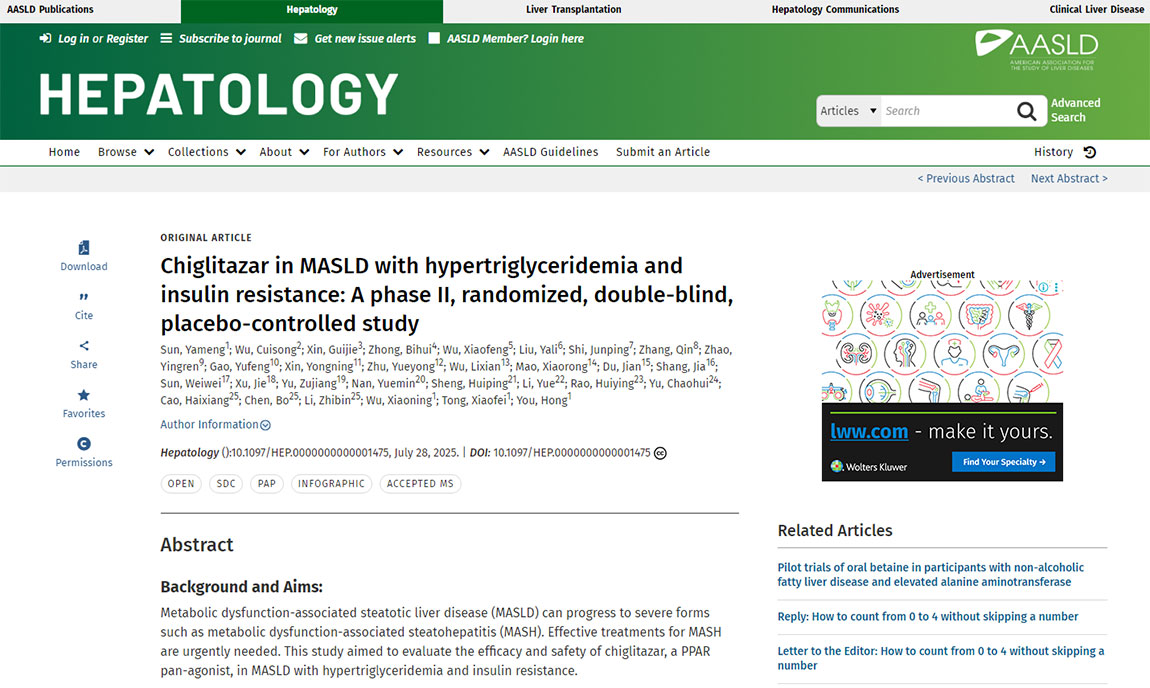August 07,2025
The Phase II clinical trial results of Chiglitazar Sodium (Bilessglu®), a proprietary type 2 diabetes treatment developed by Chipscreen Biosciences, have been published in Hepatology, one of the world’s most prestigious hepatology journals. The study evaluated Chiglitazar Sodium as a monotherapy for metabolic dysfunction-associated steatohepatitis (MASH). After 18 weeks of treatment, patients experienced a 40% reduction in liver fat content, with more than 70% achieving normalization of liver enzyme levels. In 2024, this research was notably the only innovative achievement from China selected for an oral presentation at the annual meeting of the American Association for the Study of Liver Diseases (AASLD).

Challenges in MASH Treatment Remain Unresolved
Metabolically dysfunction-associated steatotic liver disease (MASLD) has become the leading cause of chronic liver disease worldwide, affecting an estimated 32.4% of adults globally. In China, MASLD has now surpassed chronic hepatitis B to become the most prevalent liver disease. Metabolically-dysfunction-associated steatohepatitis (MASH), formerly known as non-alcoholic steatohepatitis (NASH), is a more severe stage of MASLD, marked by excessive fat accumulation and inflammation in the liver. Around 15% to 25% of MASLD patients progress to MASH.
MASH can progress to liver fibrosis, cirrhosis, liver failure, or even hepatocellular carcinoma, posing a serious health risk to patients. However, most patients exhibit no obvious symptoms in the early stages, and the absence of reliable diagnostic tools means the true prevalence of MASH is likely underestimated. At present, lifestyle modification remains the primary treatment approach, underscoring the urgent need for innovative therapies that can reverse liver fibrosis or slow disease progression. However, drug development faces significant hurdles due to the disease’s complex pathogenesis, high heterogeneity, and diagnostic challenges. To date, only one therapy has been approved by the U.S. FDA for MASH patients with moderate to severe liver fibrosis. No treatments have yet been approved in China, leaving a substantial unmet medical need in this area.
Multidimensional Benefits Highlight Therapeutic Potential
Findings published in Hepatology come from a multicenter, randomized, double-blind, placebo-controlled Phase II clinical trial led by Professor You Hong of Beijing Friendship Hospital, Capital Medical University. The study enrolled 104 eligible MASLD patients, who were randomized into three groups: 48 mg Chiglitazar Sodium, 64 mg Chiglitazar Sodium, and a placebo group. The treatment investigational product was administered once daily for 18 weeks.
Chiglitazar Sodium demonstrated multidimensional therapeutic benefits in MASH. Liver fat content was reduced by 28.1% and 39.5% in the 48 mg and 64 mg treatment groups, respectively, with 40.5% and 65.9% of patients achieving a reduction of more than 30% in hepatic fat content.
In terms of liver health improvement, patients in the high-dose group experienced more than a 50% reduction in alanine aminotransferase (ALT) levels from baseline, with over 70% achieving normalized ALT values—indicating effective hepatocyte repair. Key biomarkers of chronic inflammation and liver injury, including CK-18 and bilirubin, also showed significant declines. The high-dose group further demonstrated a 2 kPa reduction in liver stiffness measurement (LSM), with results displaying clear dose- and time-dependent trends. These findings offer new insights into potential strategies for reversing liver fibrosis.
Notably, Chiglitazar Sodium also delivered therapeutic benefits in a high-risk MASH subgroup defined by specific clinical criteria. From a safety perspective, the drug was well tolerated at both dose levels, with most adverse events classified as mild to moderate, and few serious adverse events (all unrelated to the study drug).
New Evidence Supports Integrated Management of Diabetes and Liver Disease
Diabetes is one of the most common chronic conditions, with over half of patients also affected by metabolic dysfunction-associated steatotic liver disease (MASLD). Likewise, most clinically diagnosed MASH patients have coexisting diabetes. In recent years, the concept of “integrated diabetes-liver disease management” has highlighted the importance of addressing both glycemic control and liver health in the treatment of metabolic disorders such as diabetes and MASH. For patients with these comorbidities, an ideal therapy should provide comprehensive, multidimensional benefits—effectively reducing hepatic fat accumulation, improving insulin resistance, regulating blood lipids, alleviating liver inflammation, and preventing or reversing fibrosis. Such an approach targets the root causes of these conditions while maintaining strong safety and tolerability. A recent real-world study published in Diabetes & Metabolism, the official journal of the French Diabetes Society, showed that Chiglitazar Sodium significantly reduces hepatic fat content in patients with both diabetes and MASLD. These findings underscore the drug’s potential value as a multi-target therapy aligned with the “integrated diabetes-liver disease management” approach.
Chiglitazar Sodium is approved in China as a monotherapy for type 2 diabetes and was added to the National Reimbursement Drug List in 2023. In July 2024, approval was granted for its use in combination with metformin. As the world’s first PPAR pan-agonist, Chiglitazar Sodium can simultaneously and moderately activate PPARα, PPARγ, and PPARδ receptors, helping to regulate glucose, lipid, and energy metabolism. This “triple-target synergy with multi-metabolic pathway intervention” mechanism gives the drug unique multidimensional regulatory advantages. Previous clinical studies have demonstrated that Chiglitazar Sodium significantly improves insulin resistance and provides sustained glycemic control. In terms of metabolic regulation, it also reduces triglyceride levels and markedly decreases hepatic fat accumulation, offering an optimized, comprehensive management solution for diabetic patients with fatty liver disease.
With the increasing number of patients living with both MASH and diabetes, there is a pressing clinical need for therapies that can simultaneously improve liver and metabolic health. Chiglitazar Sodium shows promise in addressing this complex challenge through its multi-target mechanism, which concurrently improves both hepatic and metabolic parameters. This positions the therapy as a potential sustainable solution for comprehensive management of chronic metabolic and liver diseases in China.
2025.07.09
2025.07.27
2025.07.31